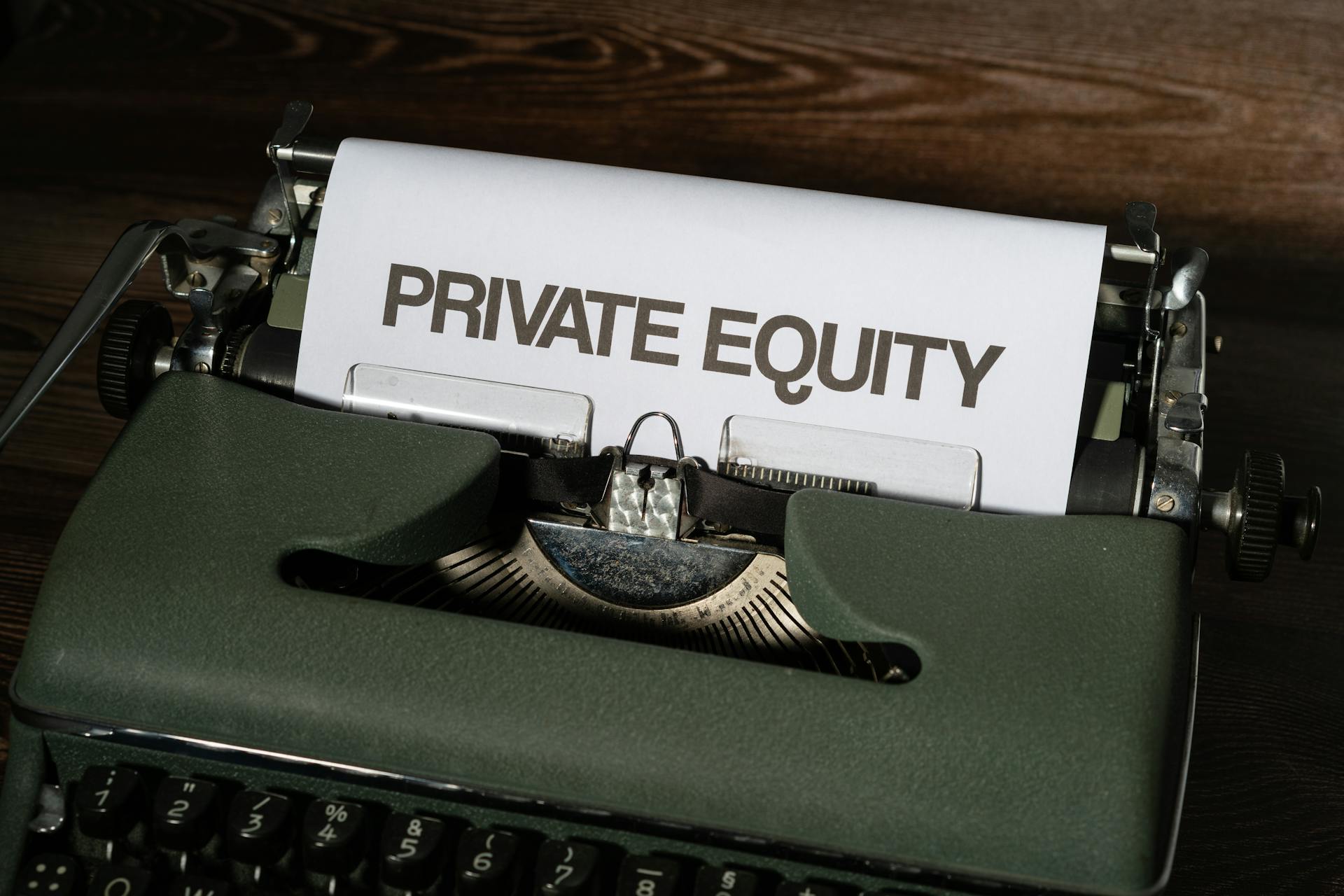
Home equity loans can be a great way to tap into your home's value, but it's essential to understand how they work. A home equity loan allows you to borrow a lump sum of money using your home as collateral.
You can borrow up to 80% of your home's value, minus any outstanding mortgage balance. For example, if your home is worth $200,000 and you owe $100,000 on your mortgage, you could borrow up to $80,000.
The interest rate on a home equity loan is typically lower than a credit card or personal loan, and the loan term can be up to 30 years. However, you'll need to consider the fees associated with the loan, such as origination fees and closing costs.
A home equity loan can provide a lump sum of money for a specific purpose, such as paying off high-interest debt, financing home renovations, or covering unexpected expenses.
Intriguing read: Interest Only Home Mortgage Loans
What Is a Home Equity Loan?

A home equity loan is a type of consumer debt that allows homeowners to borrow against the equity in their homes. Home equity loans are also known as equity loans, home equity installment loans, or second mortgages.
The loan amount is based on the difference between the home's current market value and the homeowner's mortgage balance due. This means that if your home is valued at $600,000 and you owe $400,000 on your loan, you have $200,000 in home equity, which you can borrow against.
Home equity loans tend to be fixed-rate, which means the interest rate remains the same over the life of the loan. This can provide stability and predictability for homeowners who need access to cash.
You can borrow a specific amount with a home equity loan, but you may need to borrow a large sum upfront, which can be a drawback. Additionally, it can be difficult to qualify for a home equity loan, and you put your home at risk if you're unable to repay the loan.
Check this out: What Is a Variable Rate Heloc

Here's a summary of the key characteristics of a home equity loan:
How it Works
A home equity loan is a loan for a set amount of money, repaid over a set period that uses the equity you have in your home as collateral for the loan. This means you can borrow up to 85% of your home's value, minus what you owe on your primary mortgage.
You can borrow money from a home equity loan, but you'll have to make both principal and interest payments until you've paid off what you've borrowed. The repayment period can be 20 years or more, which can be a long time to pay off a loan.
During the draw period, which can last 10 years, you can borrow money and make interest payments, but payments towards the principal are optional. This can be a good option if you need access to cash for a big expense, but keep in mind that the monthly payments can rise sharply during the repayment period.
For more insights, see: Interest Only Heloc

Here's a summary of the two phases of a home equity loan:
What Is a Line of Credit?
A line of credit is essentially a second mortgage that lets you tap into the value of your home. You can borrow against your equity, which is the home's value minus the amount you owe on the primary mortgage.
You can usually borrow up to 85% of your equity, though this varies by lender. The process of getting a line of credit is similar to applying for a purchase or refinance mortgage.
To get a line of credit, you'll need to calculate your existing equity and decide how much you need to borrow. You'll also need to gather necessary documentation, such as W-2s and mortgage statements, before applying.
The underwriting process can take weeks, so be patient and ask questions to ensure the line of credit will fit your needs. Your lender may order an appraisal to confirm the home's value, which can affect the amount of equity you have.
A unique perspective: Heloc Approval Process

A good credit score is essential for getting a line of credit with favorable terms. A credit score of 800 or higher can provide you with the best results. If your credit score isn't quite there, making consistent on-time mortgage payments can help raise it.
To improve your chances of being approved, consider the following:
- Your credit score: A good credit score will usually provide you with the best results.
- Your current loan-to-value (LTV) ratio: Be sure you've built enough equity in your home. Requirements vary, but you'll likely want this ratio comparing your first mortgage balance to your home's value to be 80% or less.
- Your debt-to-income (DTI) ratio: Having too much debt compared to your income can work against you.
By understanding how a line of credit works and what's required, you can make an informed decision about whether it's right for you.
How It Works?
A HELOC gives you the flexibility to borrow against your home equity, repay and repeat. It's typically competitive in terms of interest rates, but also comes with a risk of losing your home if you can't make payments.
There are two phases of a HELOC: the draw period and the repayment period. The draw period is when you can borrow money from the account, up to your approved limit, and make interest payments, but principal payments are optional. This period usually lasts 10 years.
You might like: Home Loan Grace Period

During the draw period, the monthly payments are relatively low, as you're only paying interest. But be aware that you can't borrow more money once the draw period is over.
The repayment period is when you can't take out more money and have to make both principal and interest payments until you've paid off what you've borrowed. This period can be as long as 20 years, and the monthly payments can rise sharply compared to the draw period.
A home equity loan is a loan for a set amount of money, repaid over a set period, that uses the equity in your home as collateral. If you're unable to pay back the loan, you may lose your home to foreclosure.
Here's a quick comparison between a HELOC and a home equity loan:
How a Home Works
A home equity loan is a type of loan that lets you borrow money using the equity in your home as collateral. You can borrow up to 90% of your home's equity, though some lenders might lend more.

The loan terms for a home equity loan can vary, but most lenders offer terms between 5 and 30 years. This means you can choose a repayment period that fits your needs.
You'll get a fixed interest rate that remains the same throughout the life of the loan. This can be beneficial if you're looking for predictable monthly payments.
You'll make monthly payments, which may have a prepayment penalty if you pay off the loan early. This is something to consider if you're planning to pay off the loan quickly.
Here are the key benefits of a home equity loan:
- Fixed interest rate
- Lower interest rates
- Variety of loan terms
How it Works
A home equity loan is a type of loan that allows you to borrow money using the equity in your home as collateral. The loan amount is typically based on the value of your home and the amount of equity you have built up over time.
The loan terms for a home equity loan can vary, but they usually range from 5 to 30 years. This means you can choose a repayment period that fits your needs and budget.
Recommended read: Minimum Home Loan Amount

A fixed interest rate is a common feature of home equity loans, which means the interest rate you're charged stays the same throughout the life of the loan. This can help you budget your payments and avoid surprises.
You can also expect to have a variety of repayment options, including monthly installments, which may include a prepayment penalty. Borrowing limits for home equity loans typically range from 80% to 90% of your home's equity, although some lenders may offer more.
Here are the key features of a home equity loan at a glance:
A HELOC, or home equity line of credit, works differently. It allows you to borrow money against your home's equity, repay it, and then borrow again. This can be a flexible option, but it's also riskier because you can lose your home if you can't make your payments.
Simultaneous Possibility
You can have both a HELOC and a home equity loan at the same time, provided you have enough equity in your home, as well as the income and credit to get approved for both.

Having a HELOC and a home equity loan simultaneously is possible, but you'll need to meet the lender's requirements for both types of loans.
A home equity line of credit (HELOC) is not a separate loan product, but rather a combination of two existing different loan products: a home equity line of credit and a home equity loan.
You can have a HELOC and a home equity loan if the total of the balances on the mortgage, any existing HELOCs, any existing home equity loans, and the new home equity loan is 90% or less of the appraised value of the home.
For example, if your home was appraised at $500,000 and you have an existing mortgage balance of $200,000, you could take out a home equity loan for up to $250,000 and still have enough equity for a HELOC.
Benefits and Drawbacks
A home equity loan can be a great way to tap into your home's value, but it's essential to understand the benefits and drawbacks before making a decision. You can use a home equity loan for home repairs and renovations, which can increase your home's value.
Related reading: How Do I Know If My Loan Is a Heloc

A HELOC often comes with a variable interest rate, whereas home equity loans typically have fixed interest rates, which can save you from a future payment shock if interest rates rise. You can borrow a significantly higher sum with a home equity loan than with an unsecured loan, with some lenders offering amounts between $35,000 and $300,000.
Here are some key benefits and drawbacks to consider:
- Fixed rates and fixed monthly payments can make it easier to budget.
- The interest on your HELOC may be tax-deductible if you use the money for home improvements.
- HELOCs can be used like a revolving line of credit, letting you tap your home's value as needed.
Pros and Cons
A home equity loan or line of credit can be a great way to access some extra cash, but it's essential to consider the pros and cons before making a decision.
You can get a fixed interest rate with a home equity loan, which means your interest charges won't change over the life of the loan. This can make budgeting a lot easier.
Home equity loans typically come with lower interest rates than credit cards and personal loans, because your home is collateral. This can save you a significant amount of money in interest payments.
Expand your knowledge: No Interest Heloc

A HELOC works like a credit card, but with a lower interest rate, and you can borrow only what you need. This can be a great option if you're not sure how much money you'll need for a project.
One of the biggest benefits of a HELOC is that it can be a good way to increase your home's value through home repairs and renovations. This can be a smart investment for the future.
Here are some key pros and cons to consider:
- Fixed interest rates with home equity loans
- Lower interest rates than credit cards and personal loans
- Ability to borrow only what you need with a HELOC
- Potentially high borrowing limits with a HELOC
- Interest on a HELOC may be tax-deductible if used for home improvements
With a home equity loan, you'll have fixed monthly payments, making it easier to budget. However, this also means you'll be locked into a specific payment schedule.
Cons
A home equity loan or line of credit can be a great way to tap into your home's value, but it's essential to consider the potential drawbacks. You put your home at risk if you default on payments, which could lead to foreclosure.

You need to borrow a specific amount upfront, and you pay interest on the entire lump sum, even if you don't use all the money. This can be a significant expense, especially if you're not sure how much you'll need.
Borrowers must meet the lender's requirements to be approved for a home equity loan, which can be challenging. You'll typically need a good credit score, enough equity in your home, and an acceptable debt-to-income ratio.
Here are some key cons to consider:
- Variable interest rate
- Temptation to spend
- Risk of losing your home
The variable interest rate can change over time, affecting your monthly payments and making it harder to budget. You might be tempted to use the available credit for non-essential purchases, which can lead to financial difficulties.
Pros and Cons of a Line of Credit
A line of credit can be a great option for homeowners, but like any financial decision, it's essential to weigh the pros and cons.
A HELOC is often used for home repairs and renovations, which can increase your home's value. This is a significant advantage, especially if you're planning to sell your home in the future.

One of the biggest benefits of a HELOC is that you could get a better rate than with an unsecured loan. This can save you money on interest payments over time.
The interest on your HELOC may be tax-deductible if you use the money to buy, build or substantially improve your home, and the combination of the HELOC and your mortgage don't exceed stated loan limits, according to the IRS.
However, it's worth noting that a HELOC increases the risk of foreclosure if you can't pay the loan. This is a serious consideration that should not be taken lightly.
A HELOC is not recommended if your income is unstable or if you won't be able to afford payments if interest rates rise. This is a crucial factor to consider before taking out a HELOC.
Here are some key points to keep in mind:
- A HELOC is often used for home repairs and renovations.
- You could get a better rate with a HELOC than with an unsecured loan.
- The interest on your HELOC may be tax-deductible under certain conditions.
- A HELOC increases the risk of foreclosure if you can't pay the loan.
- A HELOC is not recommended if your income is unstable or if you won't be able to afford payments if interest rates rise.
Frequently Asked Questions
Is it a good idea to borrow from your home equity?
Borrowing from your home equity can be a good idea if you use the funds wisely to grow your home's value, but it's essential to consider the risks of foreclosure if you're unable to repay. Before making a decision, it's recommended to weigh the potential benefits against the potential consequences.
How much is a $50,000 home equity loan per month?
For a $50,000 home equity loan, monthly payments range from $489 to $620, depending on your creditworthiness. However, your interest rate and terms may vary if you have a less-than-perfect credit score.
What is the monthly payment on a $100,000 home equity loan?
The monthly payment on a $100,000 home equity loan varies depending on the loan term and interest rate, but here are two examples: $1,239.86 per month for a 10-year fixed loan at 8.50%, and $979.47 per month for a 15-year fixed loan at 8.41%.
Is it hard to take out an equity loan?
Getting approved for a home equity loan can be challenging with credit scores below 620, but having good credit can make the process easier and lower your interest rate. A good credit score can simplify the process and save you money.
Sources
- https://www.nerdwallet.com/article/mortgages/heloc-home-equity-line-of-credit
- https://www.investopedia.com/terms/h/homeequityloan.asp
- https://www.discover.com/home-loans/articles/how-home-equity-loans-work-rates-terms-repayment/
- https://www.truist.com/money-mindset/principles/homeowning-happiness/smart-ways-to-use-home-equity
- https://www.credible.com/mortgage/what-is-a-home-equity-loan
Featured Images: pexels.com


